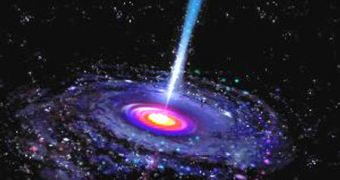In a study to be published in an upcoming issue of the journal Monthly Notices of the Royal Astronomical Society, experts at the Harvard-Smithsonian Center for Astrophysics argue that hundreds or thousands of rogue black holes could exist in the Milky Way, and that they could also reside all around us. Theories relating to this type of black holes are not new, but the scientists have now created a computer model of the early Universe, and it shows that the black holes are, indeed, real, and that their numbers are even greater than first predicted.
Astrophysicists explain that, in the early Universe, when small, dwarf galaxies began to form, each of them had a black hole in the middle. Over billions of years, as they repeatedly collided with each other and formed large-scale ones, such as the Milky Way, the black holes at their centers did not die, but rather shrouded themselves in mystery. The Harvard experts believe that, even now, these low-mass formations could be located in small star clusters all around the Milky Way.
“These black holes are relics of the Milky Way's past. You could say that we are archaeologists studying those relics to learn about our galaxy's history and the formation history of black holes in the early universe,” Center for Astrophysics researcher Avi Loeb explained. Basically, the most important thing about these formations is that they date to an age when the Universe was not so clogged with galaxies. In fact, the larger ones that formed incorporated the primeval black holes as well. Despite the fact that black holes are usually regarded by humans as dangerous, astronomers alienate concerns by saying that the closest one is at least a few thousand light-years away from our planet.
“Until now, astronomers were not searching for such a population of highly compact star clusters in the Milky Way's halo. Now that we know what to expect, we can examine existing sky surveys for this new class of objects,” Loeb added, quoted by LiveScience. “The surrounding star cluster acts much like a lighthouse that pinpoints a dangerous reef. Without the shining stars to guide our way, the black holes would be all but impossible to find,” the co-author of the paper, Harvard-Smithsonian Center for Astrophysics expert Ryan O'Leary, concluded.

 14 DAY TRIAL //
14 DAY TRIAL //